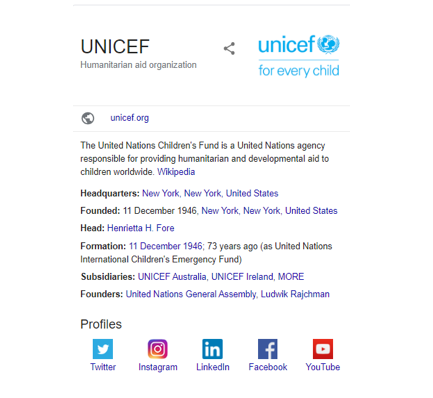Before we dive deep into the how-tos of creating meta descriptions, let’s first have a rundown of the essential things to know about meta descriptions.
First, what is a meta description? Also called a meta description tag, it is a brief snippet of text which summarizes the content of a particular webpage. You can see the meta description right below the clickable blue link on the search engine results page (SERP), or as pictured below:
Now, don’t get yourself confused when you come across a similar term called a meta tag. Meta tags are also snippets of text that describe your webpage’s content, but unlike meta descriptions, meta tags aren’t displayed for online users to see. Rather, meta tags are placed into a page’s source code that Google and other search engines use to understand your content.
Second, why do you need to write a meta description for your content? Since meta descriptions provide a summary of what your content is all about, they can help you increase your clickthrough rates (CTRs) and site traffic from organic search. However, this can only happen if you’re ranking on top of the SERPs, where more people can see your link.
So, how can you use meta descriptions to boost your ranking? The general rule is following SEO copywriting practices, which will help you optimize your content, including your meta descriptions.
With that said, here are a few tips and tricks for creating amazing meta descriptions to drive traffic to your site and, ultimately, convert visitors. You’ll also find some examples that you can use when writing meta descriptions for your target audience.
1. Include the entire keyword or search phrase for which you want to rank for
You already know how keywords work in SEO. Each time you write content, you include keywords and phrases that people may be using to find products or services on the internet.
Therefore, to help users know that your webpage answers their query, you need to include your content’s most relevant keywords in your meta description.
HubSpot suggests that you make it easy for your target users to see or follow your target keywords, just like the sample meta description below:

Anyone searching for articles on “how to plant a tree” will feel compelled to click the given link since the meta description shows the same keywords they entered on the search. Note that the keywords “how to plant a tree” are highlighted in bold, which is really helpful in directing the users’ attention to the snippet and, therefore, can influence them to go to the webpage of the company.
Be careful, though: if you’re targeting three or more sets of keywords, you should never force all of them into your meta description. Let Google bots choose the most relevant text for your meta description.
2. Avoid sounding dull or boring in your copy
As mentioned, meta descriptions are designed to get people to click your link. They work like ads for your page. It’s only right, therefore, that you put your best foot forward and create copy that users will find interesting, exciting, or engaging.
Marketing guru Neil Patel identifies the best ways to avoid boring meta descriptions:
- Use the active voice, which constructs sentences in a way that flows naturally and is easy to understand.
- Get rid of fluff by being straightforward and specific with your message.
- Use a conversational tone. Write as if you’re talking to your friend or someone you know.
Here’s a sample meta description that follows those recommendations.

3. Get rid of non-alphanumeric characters
Non-alphanumeric characters are special characters which you should avoid placing in your meta descriptions. They may look fine on your screen, but they go haywire the moment you publish them since search engines have a hard time reading these symbols. So, always check your meta descriptions for these undesirable characters, which include ampersands, em dashes, plus signs, and the like.
4. Consider using rich snippets
Rich snippets, also known as rich results, are just like any other search result that Google displays in response to a search query. However, what distinguishes rich snippets from the rest is that they show additional data, such as pricing, reviews, star ratings, calorie count, and any extra piece of information that you want the searcher to know.
There’s a variety of rich snippets that you can use depending on your business or industry. If you’re trying to promote or market your organization, your rich snippet type of meta description may look something like this:

As you can see, UNICEF’s meta description includes its mission, address, date of founding, and so on. This helps people understand essential information about the organization.
Meanwhile, the next sample meta description is from a recipe site that includes information about user ratings, reviews that people who have visited the site have left, and the required cooking time. Aside from these, meta description also tells people what makes the recipe great—that is, it’s easy to make and tastes delicious.
Foodies will also appreciate that the recipe even includes freezing instructions. Plus, there’s an image of the finished product, which makes the whole thing even more eye-catching.

5. Place a call-to-action
A CTA that focuses on the value that people can get from visiting your website can help improve your CTRs. Keep these tips in mind and study the accompanying samples as you try to make killer CTAs for your meta description:
- Start your CTA using a strong command verb, telling readers directly what they need to do.

- Use words that appeal to one’s emotion, just like the one below, as it invites you to plan the perfect vacation for your family.

- Tell your target users what they may be missing.

6. Avoid duplicate meta descriptions
Every content or page on your website needs to have its own meta description. You cannot write a meta description for a particular product page and apply it across all the other pages, or you’ll be dealing with penalties from Google. The rationale behind this is that Google wants your meta description to match the content of the page.
Bonus Tip: Mind the character count, but don’t focus on it too much
The debate over the ideal character count for meta descriptions has been going on for years. Some experts will recommend that you keep your meta descriptions to about 160 characters, which is why if you enter a search query about what meta descriptions are, you’ll see some search results include the 160-character limit in their definition.
However, since Google is continually testing and updating its algorithms, there’s no more absolute or clear-cut rule about the length of meta descriptions that you should be writing.
Neil Patel has a word of advice on how to approach this issue: instead of focusing on the number of characters, you should give more weight to user experience. As long as your meta description gives an accurate description of your page, you need not worry whether your meta description is less or more than 160 characters.
However, if you want to have a benchmark to follow, his suggestion is to keep it to about 300 to 350 characters based on how posts that rank well on Google do it.
Final Words
Writing great meta descriptions involves both art and science. You need to be creative about it to achieve a high CTR or drive more organic traffic, but at the same time, you have to look at the available data to help you see what works and what doesn’t.






